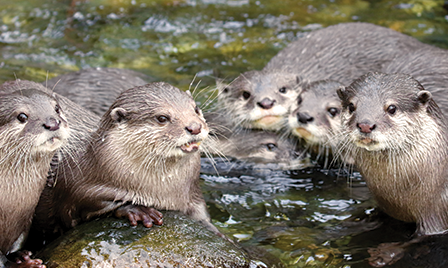Otters
River Otter
River Otter Information:
Click on the following links to learn more:
River otters (Lontra canadensis) were once abundant throughout North America, but unregulated harvest, water pollution, and overall habitat degradation decimated river otter populations across the contiguous United States. By the early 1900s, river otters were scare in Kentucky; however, due to restoration programs implemented by Kentucky Department of Fish and Wildlife Resources (KDFWR), this species has rebounded in the state. River otters can now be found throughout Kentucky.
River otters have a streamlined body, with thick muscular necks and shoulders. Occasionally confused with weasels (Mustela spp.), mink (Neovison vison), and sometimes beavers (Castor canadensis) and muskrats (Ondatra zibethicus), otters can easily be distinguished from other semi-aquatic mammals by their body characteristics and behavior. Otters have wide heads, often as wide as their necks. Their legs are short; which otters hold parallel to their bodies as they swim. Webbed feet efficiently propel otters through water. Otter tails are long and flattened, so that they appear wide from the top and narrower from the side.
River otter fur is short and typically two-toned. Dorsally (on top) otters have dark-brown fur that can appear

black when wet. Ventrally (below), the fur is typically lighter brown to beige. This coloration, known as countershading, helps otters to avoid predators from above and hide from prey below. On the muzzle, otters have prominent whiskers for sensing prey movement. River otters are adapted to a semi-aquatic lifestyle and can typically be seen “playing” in a stream, river, or alongside the banks of a waterway.
Typically, otters in northern regions are larger than otters in southern regions, and males are usually larger than females. On average, male otters weigh 25lbs and are about 48in in length; while females typically weigh 19lbs and are about 44in long. However, males have been recorded up to around 52in and 33lbs. It is difficult to determine the difference between male and female otters without having them “in hand.” Females can be distinguished from males by 4 mammary glands on the upper chest, and males from females by the presence of a bacculum (penile bone). Sexual maturity of both males and females occurs around two years of age; although, reproduction has been reported in yearling females.
Breeding generally begins in December and ends in April, with an approximate 60-day gestation period. Litters will be born as early as January and as late as June, with peak birth numbers from February through April. Litter size varies between 1 and 3 pups; however, litters of 5 individuals have been recorded. Pups are born blind and toothless; they can remain with the mother for up to 3 years. In this time, the mother will provide food for the pups while teaching them to hunt. With adequate food sources, suitable habitat, and lack of predators, river otters can live up to 13 years in the wild, with records reaching 17 years in wild otters and over 20 years in captive otters.
Otters have two main prey groups: fish and crayfish; however, otters will also consume amphibians, snakes, birds, mollusks, insects, and small mammals. Prey selection is often based on abundance and catchability (i.e., what’s available and easiest to catch). In colder months, fish are more accessible to otters, as colder water slow fish down and make them easier to for otters to catch. In summer months, crayfish become available as waters warm, while fish swim faster and are more difficult to catch than in winter. Thus, otters typically increase their consumption of easy-to-catch crayfish in the summer months, although fish still remain a large part of their diet.
Otters do not have many aquatic or terrestrial predators. In coastal regions, orcas, Orcinus orca, (Pacific coast) and alligators, Alligator missippiensis, (Gulf coast) will prey on otters, but in Kentucky, aquatic predation is rare. On land, otters lose their agility and become vulnerable to land predators, including coyotes and domestic dogs. The highest otter mortality within Kentucky is most likely human-caused events: trapping, shooting, roadkill, and accidental capture in fishing nets or set lines.
Otters are a key component in Kentucky’s aquatic ecosystems and are often appreciated for their economic and wildlife-viewing value. As the otter population grows in Kentucky, there is an increased chance of conflict between otters and humans, usually relating to the use and management of water systems, fish farming, or recreational fishing in small farm ponds. Sightings, scat, sign, and damage can all be used to determine if otters are the cause of the issues that you are having. If otters are a problem, then deterrents or removal may be necessary to deal with the issue. Deterrents can be prohibiting further entrance to damaged areas by using fences or other barriers, but may not be practical in many situations. Lethal methods are always recommended to be used as a last resort, particularly in situations where hunting or trapping seasons are not open at the time the problem is occurring. Finally, it is important to note that wildlife-human conflicts are often a reoccurring issue and solving the problem now does not guarantee that the same or a similar problem will not occur again in the future.
